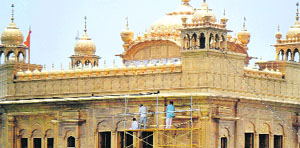Amritsar, Punjab: The Golden Temple seems to have been regaining its glitter with the annual exercise of cleaning up its gold plates underway for the last few days.
The cleaning operation has become an annual feature at the holy shrine ever since the gold plates were replaced way back in 1999 after a period of 170 years. Sources said some time after the replacement, the gold plates had gained a reddish tinge, following which a fresh coat of polish was done and the process of cleaning it up was made an annual exercise.
Experts had then termed it as a result of the rising pollution in the holy city. In the previous years, the work to clean up the gold plates was being done by the UK-based Guru Nanak Nishkam Sewak Jatha, but this time the job has been entrusted to Baba Kashmir Singh Bhuriwale. A few months back too, a blackish tinge on the gold plates was noticed at the shrine.
SGPC chief Avtar Singh Makkar attributed the discolouring of gold plates to the increasing pollution. “We will try and ascertain the exact reasons behind it with the help of experts,” he said.
As far as the pollution level around the shrine is concerned, a study conducted by the Punjab Pollution Control Board (PPCB) from January to December 2011 had corroborated the rising level, as the RSPM level had come out to be a maximum of 227 and a minimum of 124, though it should not be more than 100 microgram/cubic metre around heritage sites.
PPCB executive engineer Jaswant Singh said the IIT (Delhi) had recently submitted its report regarding the pollution around the Golden Temple to the Punjab and Haryana High Court. The IIT was roped in by the PPCB to undertake a study and suggest ways and means to restore the sheen of the shrine.
Pollution damaging gold-plating, marble:
The high level of pollution in the area is causing harm to miniature paintings and gold-plating, besides leading to corrosion and blackening of the white marble. Its adverse effects can also be seen on the gold-plating on the outer walls of the Akal Takht. Though the local administration in the past has initiated various measures like banning coal-run hearths being used by goldsmiths and providing LPG connections to them, still a lot needs to be done to make the vicinity of the shrine smoke-free. While the number of private vehicles plying in the area is also high, the rickety auto-rickshaws running on adulterated fuel also pose a severe threat to the architectural marvel that the Golden Temple is. For its part, the SGPC too is initiating measures like reducing the duration of fireworks on occasions like Diwali and modernising the kitchen alongside its langar hall in a bid to curb pollution.
History of the golden temple:
1 The Golden Temple was first covered with gold plates during the reign of Maharaja Ranjit Singh and these were later replaced in 1999
2 The task of re-gilding the domes and upper portion of the temple was entrusted by the SGPC to the UK-based Guru Nanak Nishkam Sewak Jatha in February 1995
3 Its completion coincided with the tercentenary celebrations of the foundation of the Khalsa Panth in 1999
4 The holy project entailed four years of multi-disciplinary works like gold-gilding, gold-plating, marble work, fresco painting by artisans and craftsmen from different parts of the country
5 The aim of this project was to restore the splendour of the Sikh shrine; the jatha had performed the ‘kar sewa’ in a record time of four years
6 Earlier, the gilding work was done by Mohammad Yar Khan Mistri under direct supervision of Bhai Sant Singh Giani during the era of Maharaja Ranjit Singh
7 After the death of Bhai Sant Singh, his son, Bhai Gurmukh Singh Giani, supervised the work
8 The entire work, which continued for about 25 years, was completed in 1830
Source: The Tribune
 Sikh Sangat News Celebrating Sikh culture and sharing Sikh voices
Sikh Sangat News Celebrating Sikh culture and sharing Sikh voices

